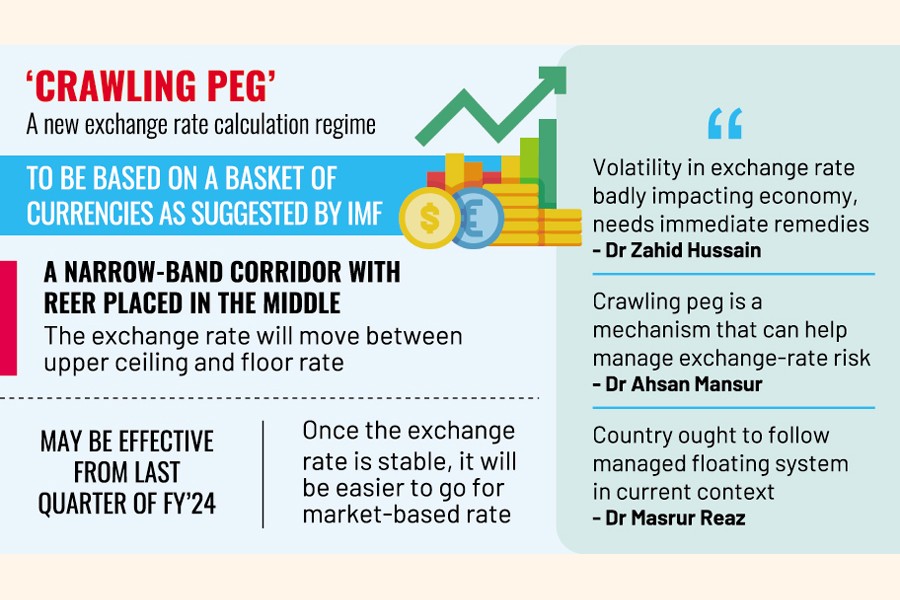
Coming up 'crawling peg' as new exchange-rate calculus in a move towards market-centric rating aimed at reducing volatility on the forex market as the central bank courts IMF-recommended reforms.
Sources at the Bangladesh Bank have said the central bank has already started spadework on introduction of the system that will be based on a basket of currencies in accordance with suggestion of the International Monetary Fund (IMF) to help manage foreign-exchange risks.
Under the new matrix, according to the sources, there will be a narrow band corridor where REER (real effective exchange rate) stands in the middle. The corridor will have an upper ceiling and floor rate and the exchange rate will move within the bounds.
It is learnt that a technical team of the IMF will be visiting Dhaka after the upcoming 12th parliamentary elections for capacity development to implement the crawling peg-based exchange regime probably from early last quarter of the ongoing financial year (FY'24).
Seeking anonymity, a BB official has said the central bank, as part of the deregulation with guardrails in place, will go for basket pegging of currencies and analyse exchange rates, REER and inflation of 15 countries, including Bangladesh, and foreign countries that will come under the mechanism and account for over 80 per cent of Bangladesh's overall imports and exports.
"We have already started works to implement this key suggestion of the IMF as part of its $4.7-billion package loan to Bangladesh. The new corridor could be launched by early last quarter of this fiscal," the central banker says.
Like the interest-rate corridor (IRC), the official adds, there will be also upper and lower ceilings while REER will be in the midpoint and the length of the corridor will not be much wide at the initial stage.
Another BB official, who also preferred not to be named, says the new system is a pathway which the exchange rate will move within. It will not only reduce the forex-market volatility but also help bring stability in the exchange rate ensuring transparency in the process.
The central bank will release REER early each week, based on the market situation that involves demand and supply. Once the espoused stability in exchange rate is in place, it will be easier to go for floating exchange rate.
Responding to a question, the central banker said: "If the interbank exchange rate is stable and predictable, the rate on the kerb market will come down and move towards the corridor."
However, economists appear critical over various issues regarding shifting towards such crawling-peg mechanism which is a lengthy process although the nation needs urgent remedies to overcome prevailing volatility on the country's forex market that casts multifaceted domino effect on life and economy.
Former lead economist of World Bank's Dhaka office Dr Zahid Hussain says the volatility in exchange rate is badly impacting the economy, which needs immediate remedies.
He feels that the current planning for switching towards new exchange- rate regime does not reflect any urgency as it would require quantitative analysis of a basket of currencies, inflation rates of too many countries and paper works, technical assistance, workshops and so on.
"So, it seems to be a lengthy process under the current context of our bureaucratic system," the eminent economist remarks.
"I don't understand the necessity of middle point in the corridor under the current macroeconomic perspective."
The country can instantly set a corridor fixing upper and lower ceilings and allow the exchange rate to move within. "We can learn by doing and keep adjusting, if necessary," Mr. Hussain suggests.
The economist notes that bilateral exchange rates do not matter for the country's exports and imports because the US dollar is being used in trade invoicing even in buying or selling products from or to outside the United States.
"When trade invoicing is mostly in dollar, the bilateral exchange rates do not matter."
Executive Director of Policy Research Institute Bangladesh (PRI) Dr Ahsan H. Mansur feels that the central bank should have taken such initiative much earlier.
He says crawling peg is a mechanism that can help manage exchange- rate risk. "But the success will depend on how smartly and efficiently the central bank can handle the process. I hope it (BB) will not take too much time in properly implementing the system."
Chairman of Policy Exchange of Bangladesh Dr M Masrur Reaz points out that exchange-rate volatility is persisting in the economy while the supply of the foreign currencies continues shrinking.
Under such circumstances, he says, it will be difficult to go for fully market-centric exchange rate. So, the country has to follow managed floating system. In the system, there is need for a systematic and rational basis where the role of crawling peg is very vital.
Simultaneously, the inflation differentials among the trading partners will play a vital role for effective functioning of the system. The rate of inflation in most trade-partner countries went down while the situation is completely opposite in Bangladesh.
"So, we need to properly control our economic fundamentals, the higher inflation in particular. Otherwise, it will put pressure on the crawling peg, which may not be sustainable in medium and longer terms," the economist says.
jubairfe1980@gmail.com
© 2025 - All Rights with The Financial Express
